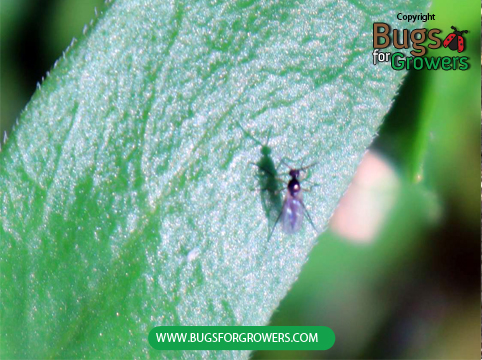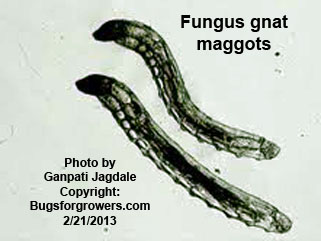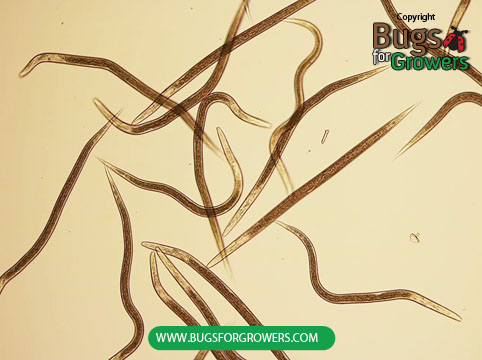What are fungus gnats?
Fungus gnats (Bradysia coprophila, B. impatiens and B. difformis) are small flies that resemble small mosquitoes, found around damp areas, decaying vegetation and algae in the greenhouses, nurseries and interior landscapes. Fungus gnat adult flies are about 3-4 mm in size, blackish or grayish in color with clear wings (Photo 1). The eggs of fungus gnats are very small, oval, shiny, white and semi-transparent. Fungus gnat larvae are whitish, slender and legless maggots with translucent bodies and black head capsules (Photo 2). The pupae of fungus gnats are small and brown in color.


Damage caused by fungus gnats
Fungus gnat flies are economically important insect pests of many indoor and greenhouse ornamental plants. Adults of fungus gnat do not cause direct damage to plants but they are a nuisance to people. However, all the larval (maggots) stages of fungus gnats cause serious damage to many ornamental plants. Although maggots primarily feed on fungi and organic matter, they are capable of feeding on healthy root and stem tissues of many plants. Maggots generally chew or strip plant roots and tunnel stems that in turn affect plant’s ability to absorb water and nutrients from soil or potting media. Maggots can damage seedlings, cuttings and roots of young plants. This results in poor growth, stunted growth, loss of vigor, yellowing, dropping of leaves and eventually death of plants. Both adults and maggots of fungus gnats also cause indirect damage by disseminating spores of plant diseases like Botrytis blight, Fusarium wilt, Pythium blight and Verticillium wilt from plant to plant when adults disperse through the greenhouse and when maggots are feeding on the plants. A very high pressure of these diseases to ornamental plants that in turn cause economic loss to growers.
Life Cycle of fungus gnats
Fungus gnats develop through four life stages including eggs, larvae, pupae and adults. Females often lay over 200 eggs singly or in clusters on the media or soil surface. Eggs hatch into small maggots within a week. These maggots then start feeding on the plant tissues and become mature within 2 weeks. Mature maggots then pupate near the soil surface. Adults start emerging from pupae within a week. Fungus gnats complete their life cycle from egg-to- adult stage within 20-25 days. These tiny insects can complete several overlapping generations in a year in the greenhouse at 20-25C.
Biological control of fungus gnats
Biological control of fungus gnats can be achieved with the application of beneficial entomopathogenic Steinernema feltiae nematodes in greenhouses, nurseries and interior landscapes.
What are beneficial entomopathogenic Steinernema feltiae nematodes?
Nematodes that are pathogenic to insects called entomopathogenic nematodes. These nematodes considered beneficial because they currently used as biological control agents for the control of fungus gnats. Beneficial Steinernema feltiae nematodes are cold tolerant and they have an intermediate foraging strategy between the ambush and cruiser type (Photo 3).

How to apply Steinernema feltiae nematodes?
Beneficial entomopathogenic Steinernema feltiae nematodes are commercially sold either in gel or granular formulations. For application of nematodes either in pots or beds, dissolve these formulations in water. Then apply this nematode suspension (about 500 -1000 infective juvenile nematodes per gallon pot or 23,000 infective juveniles per square foot area) as drench to the surface of plant growing medium for the effective control of both maggots (larvae) and pupae of fungus gnat using a water can.
Effective rates of Steinernema feltiae nematodes for fungus gnat control
- Apply 500 -1000 infective juvenile nematodes in a gallon sized pot
- Apply 23,000 infective juvenile nematodes per square foot area
How do entomopathogenic nematodes kill fungus gnats?
When the infective juveniles of Steinernema feltiae nematodes are applied to the surface of the potting medium, they move in the medium and actively search for maggots (larvae) and pupae. After locating maggots and/or pupae, nematodes enter into their body cavity via natural openings such as mouth, anus and breathing pores. When Steinernema feltiae nematodes are in the body cavity, they release symbiotic bacteria (Xenorhabdus spp.) in the blood of larvae or pupae. In the blood, multiplying bacteria causes septicemia and kills both the larvae and pupae usually within 48 hours after infection. Nematodes feed on multiplying bacteria, mature, reproduce and then emerge as infective juveniles from the cadaver to seek new maggots and pupae in the potting medium/soil.
